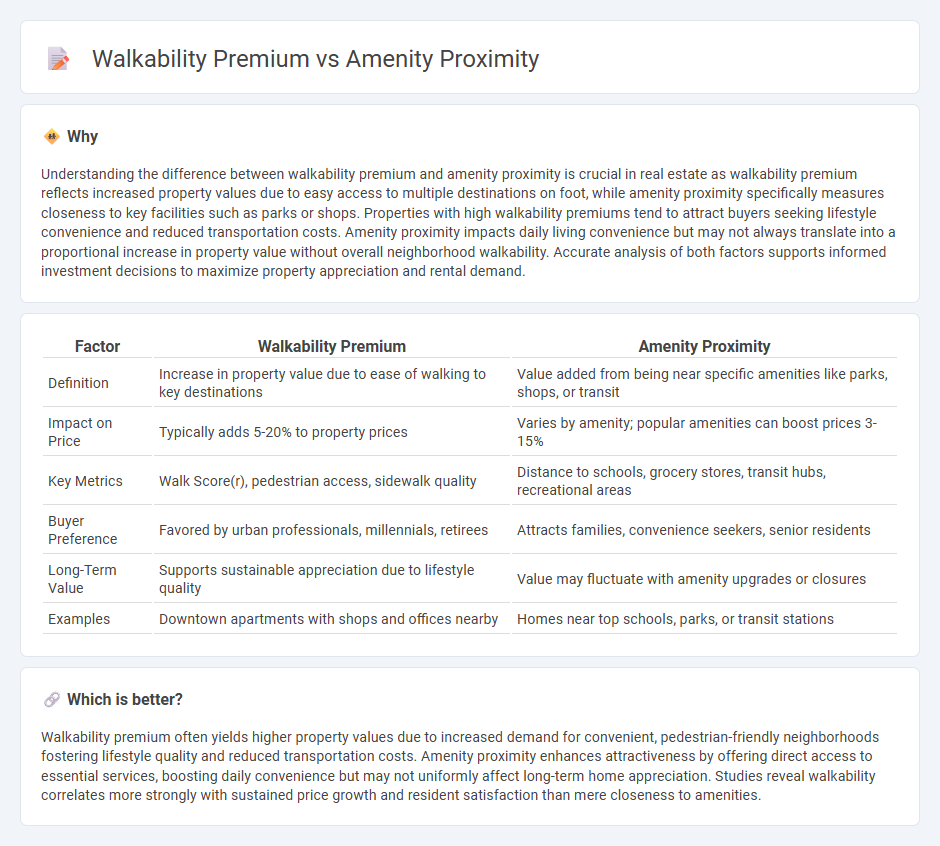
Walkability premium in real estate reflects the increased property value attributed to easy access to daily necessities within walking distance, emphasizing pedestrian-friendly environments. Amenity proximity focuses on closeness to specific attractions such as parks, schools, or shopping centers, which enhances lifestyle convenience and desirability. Discover how these factors influence market trends and investment decisions in real estate.
Why it is important
Understanding the difference between walkability premium and amenity proximity is crucial in real estate as walkability premium reflects increased property values due to easy access to multiple destinations on foot, while amenity proximity specifically measures closeness to key facilities such as parks or shops. Properties with high walkability premiums tend to attract buyers seeking lifestyle convenience and reduced transportation costs. Amenity proximity impacts daily living convenience but may not always translate into a proportional increase in property value without overall neighborhood walkability. Accurate analysis of both factors supports informed investment decisions to maximize property appreciation and rental demand.
Comparison Table
| Factor | Walkability Premium | Amenity Proximity |
|---|---|---|
| Definition | Increase in property value due to ease of walking to key destinations | Value added from being near specific amenities like parks, shops, or transit |
| Impact on Price | Typically adds 5-20% to property prices | Varies by amenity; popular amenities can boost prices 3-15% |
| Key Metrics | Walk Score(r), pedestrian access, sidewalk quality | Distance to schools, grocery stores, transit hubs, recreational areas |
| Buyer Preference | Favored by urban professionals, millennials, retirees | Attracts families, convenience seekers, senior residents |
| Long-Term Value | Supports sustainable appreciation due to lifestyle quality | Value may fluctuate with amenity upgrades or closures |
| Examples | Downtown apartments with shops and offices nearby | Homes near top schools, parks, or transit stations |
Which is better?
Walkability premium often yields higher property values due to increased demand for convenient, pedestrian-friendly neighborhoods fostering lifestyle quality and reduced transportation costs. Amenity proximity enhances attractiveness by offering direct access to essential services, boosting daily convenience but may not uniformly affect long-term home appreciation. Studies reveal walkability correlates more strongly with sustained price growth and resident satisfaction than mere closeness to amenities.
Connection
Walkability premium significantly increases real estate values by enhancing access to amenities such as shops, parks, and transit hubs within a short distance. Properties located near essential services and recreational facilities command higher prices due to convenience and quality of life improvements. This correlation between walkability and amenity proximity drives demand in urban housing markets and influences investment strategies.
Key Terms
Accessibility
Amenity proximity refers to the closeness of essential services and recreational facilities to a property, significantly enhancing its accessibility and convenience for residents. Walkability premium captures the added value attributed to neighborhoods with pedestrian-friendly infrastructure, enabling easy access to shops, parks, and public transit without relying on a car. Explore how optimizing amenity proximity and walkability can elevate property value and improve quality of life.
Location Value
Amenity proximity enhances location value by providing easy access to essential services like grocery stores, cafes, and parks, directly influencing property desirability. Walkability premium captures the increased property value attributed to pedestrian-friendly neighborhoods with safe sidewalks, mixed-use developments, and transit options. Explore how optimizing both amenity proximity and walkability can maximize real estate investment returns and quality of urban life.
Urban Planning
Amenity proximity measures how close essential services like grocery stores, parks, and schools are to residences, directly influencing urban living convenience and property values. Walkability premium reflects the added market value properties gain due to accessible, pedestrian-friendly environments that encourage walking and reduce reliance on vehicles. Explore how these concepts shape sustainable urban planning strategies for vibrant, livable cities.
Source and External Links
Measuring proximity to services and amenities: An experimental set ... - Proximity to amenities such as grocery stores, schools, pharmacies, health care, and public transit is measured to assess social inclusion, with about 20% of Canadians living in "amenity dense" neighborhoods meeting specific distance criteria for key services within walking or driving distances.
Amenity proximity analysis for sustainable brownfield redevelopment planning - Proximity analysis evaluates walking distances to amenities like schools, parks, and commercial facilities to support sustainable urban planning and reduce residents' travel distances to essential services.
How Home Proximity to Amenities Affects Value - Proximity to amenities such as schools, parks, shopping centers, and healthcare significantly influences home value and desirability, with properties near top-rated schools often commanding premium prices due to convenience and lifestyle benefits.
 dowidth.com
dowidth.com